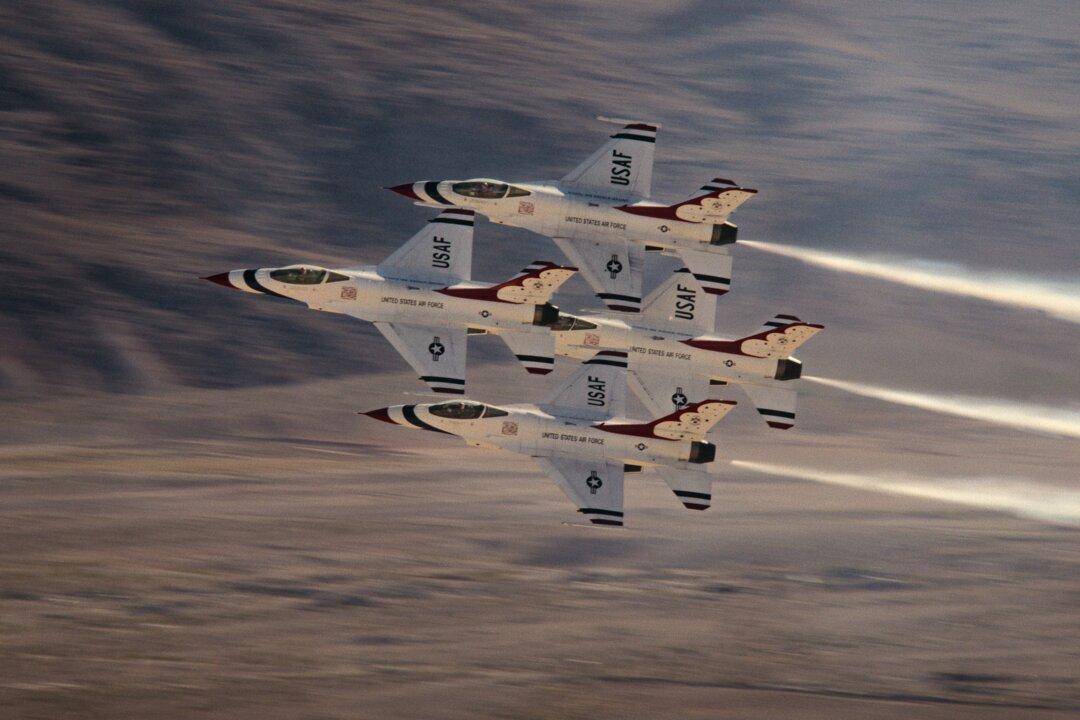TV-14 | 1h 31m | Documentary | 2025
The United States Air Force’s official motto is “Aim High … Fly-Fight-Win” and they are closely associated with the phrase “up, up, and away.” However, their special aerial demonstration squadron, the Thunderbirds, fly daringly close to the ground, to afford spectators a good look. They also fly in dazzlingly close formations.
Such flying requires tremendous discipline, as viewers quickly understand from watching filmmaker Matt Wilcox follow the squadron over the course of a season in the Netflix documentary, “Air Force Elite: Thunderbirds.”
Every member of the Thunderbirds serves a two-year overlapping tour of duty. Consequently, each year the squadron must be recertified (or cleared for performance duty) with the new members. It is never an easy process for incoming recruits.

Very much like the Navy’s Blue Angels, the Thunderbirds squadron consists of six performance pilots: two “soloists” and the four-plane precision diamond formation, which periodically combine into a six-plane triangle formation. For the Thunderbirds’ grand finale, “the High Bomb-Burst,” the diamond formation breaks apart in four different directions, intersects in a crossing pattern, and then re-forms back into the diamond at “air show center.” It is much easier said than done.
‘Astro’
Fortunately, the Thunderbirds had a strong “boss” that year in Lt. Col. Justin Elliott, call sign: “Astro.” In fact, his story helps differentiate Wilcox’s Thunderbirds documentary from Paul Crowder’s “The Blue Angels,” produced by Amazon MGM Studios, and which released almost a year earlier to the day. Both productions share several of the same aerial cinematography specialists; aerial director of photography Michael FitzMaurice also worked on “Top Gun: Maverick.”Unlike the other Thunderbirds, Elliott had long aspired to join the astronaut program. In his case, his ambitions were justified. Thanks to his training as both a fighter pilot and a test pilot, he had successfully advanced deep into the astronaut selection process when he was asked to lead the Thunderbirds. Selflessly, Elliott relinquished his dreams of space, to answer the call from the Air Force and his country, to rebuild the Thunderbirds after several difficult seasons.
Indeed, Wilcox and the current Thunderbirds forthrightly discuss the squadron’s previous tragedies, including the so-called “diamond crash” of 1982. Wilcox also visits at length with the family of Maj. Stephen “Cajun” Del Bagno, the Thunderbirds’ most recent fatality. Tragically, he crashed while performing the High Bomb-Burst, a fact not lost on Lt. Col. Elliott, as the three new squadron recruits struggle with the challenging maneuver.

Ever-present Danger
Frankly, danger always remains real and ever-present for all military pilots. That is especially true for the Thunderbirds (and their Blue Angel counterparts). Even a safe ejector seat release entails risks. For instance, incoming recruit Maj. Eric “Miami” Tise, safely ejected before joining the Thunderbirds, but lost an entire inch of height as a result due to muscle compression caused by extreme G-forces, which entails considerable health challenges.Indeed, Wilcox and his camera crew give viewers a vivid sense of the ejection experience. They also capture some stunning photography of the Thunderbirds in flight. Arguably, the flying sequences are even more spectacular in the Blue Angels documentary. That also might explain why Crowder’s film also had an IMAX release prior to its streaming debut.
All Americans should admire the Thunderbirds’ service and sacrifice. Lt. Col. Elliott eloquently explains how he hopes their example of excellence will inspire the Air Force rank and file and the nation in general. Those are certainly worthy goals that the squadron regularly achieves.

Yet the Thunderbirds and Blue Angels serve another important purpose. They exhibit to the rest of the world the exceptional proficiency of American military aviators. Few hostile fighter pilots would relish the prospect of a dogfight with a former Thunderbird, who typically rotate back to regular active duty (and potential combat roles) after their two-year tours.
Both “Air Force Elite: Thunderbirds” and “The Blue Angels” are very highly recommended for anyone who appreciates the skill and derring-do of exhibition aviation. Maybe someone should next produce a documentary on the Army’s Golden Knights exhibition parachuting team, to make it an unofficial, cross-platform trilogy. Regardless, the aerial cinematography should impress any and all viewers of “Air Force Elite; Thunderbirds.”







